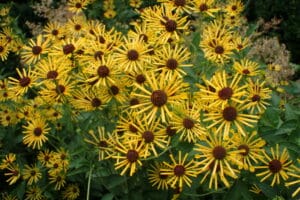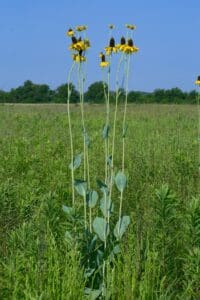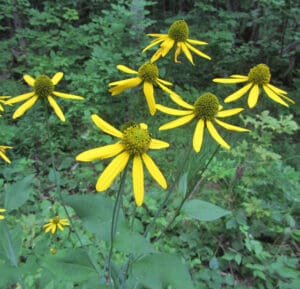Is it a coneflower? Is it a daisy? No, it’s a Black Eyed Susan, or a Susie. The Rudbeckias (the Latin, or scientific name) are a large genus (a group of living things with similar characteristics that is further subdivided into species), that is familiar to us all. With several different species, there is at least one Black Eyed Susan that will fit in your garden.
Rudbeckias are found in different habitats, from damp woodlands to dry prairies, but none are very picky about their growing conditions. All prefer sun to part shade and moist to average soil. They are generally fairly drought and heat tolerant when established. They are clump formers, meaning they won’t spread by runners; they are well behaved in your garden. Most are fairly coarse in texture, so planting them with a finer, fluffier plant like a Hubricht’s amsonia would make a pretty combination. All have roughly the same familiar Black Eyed Susan flower, but with a few differences: the cone section can be brown or black, and can get quite prominent in some.
All Rudbeckias are great pollinator plants. Small finches love the seeds, so try to avoid deadheading at the end of their blooming season.
Here are three less common members of the Black Eyed Susan genus that make great garden plants.

Rudbeckia subtomentosa ‘Henry Eilers’ has lovely delicate flowers. The petals are quilled, meaning they are rolled into little tubes with a tiny flat area on the end, subtle and beautiful. The lemon yellow flower itself is about 2 inches across. The whole plant can get to 4 to 5’ tall, with stiff stems that won’t break in the wind. It is very low maintenance, like all Susie’s and makes an excellent cut flower, particularly with its long stems.

Rudbeckia maxima, the Giant Coneflower. A spectacular plant! Growing to 5 to 6’ tall with large, grayish blue leaves, it is a strong vertical accent in your garden. It has tall upright single stems each crowned with a yellow flower with a large cone. Very striking in front of a stand of Zagreb tickseed, faced down with some Lyreleaf sage.

And, last but not least, Rudbeckia laciniata, Cut leaf coneflower, which can get to to 10’ tall. Imagine a 10’ Black eyed Susan! The leaves are a beautiful medium green, lobed, a little like a maple leaf. The cones on these flowers are a dark yellow green. This plant can take some shade, and likes a moister soil – its natural habitat is moist woods and along stream banks. It would be very nice paired with some Switchgrass, which would help hold it up and whose chunkier form would be a good contrast to its open habit.
All these summer and late summer blooming plants would look wonderful planted in the middle to the rear of your garden. Give yourself a treat and plant one today!
Written by Liz Nalle.
